+ データを開く
データを開く
- 基本情報
基本情報
| 登録情報 | データベース: PDB / ID: 7x90 | ||||||
|---|---|---|---|---|---|---|---|
| タイトル | The SARS-CoV-2 receptor binding domain bound with the Fab fragment of a human neutralizing antibody Ab326 | ||||||
 要素 要素 |
| ||||||
 キーワード キーワード | VIRAL PROTEIN / severe acute respiratory syndrome coronavirus-2 (SARS-CoV-2) spike trimer / COVID-19 / human neutralizing antibody / RBD | ||||||
| 機能・相同性 |  機能・相同性情報 機能・相同性情報Maturation of spike protein / viral translation / Translation of Structural Proteins / Virion Assembly and Release / host cell surface / host extracellular space / suppression by virus of host tetherin activity / Induction of Cell-Cell Fusion / structural constituent of virion / entry receptor-mediated virion attachment to host cell ...Maturation of spike protein / viral translation / Translation of Structural Proteins / Virion Assembly and Release / host cell surface / host extracellular space / suppression by virus of host tetherin activity / Induction of Cell-Cell Fusion / structural constituent of virion / entry receptor-mediated virion attachment to host cell / host cell endoplasmic reticulum-Golgi intermediate compartment membrane / membrane fusion / receptor-mediated endocytosis of virus by host cell / Attachment and Entry / positive regulation of viral entry into host cell / receptor-mediated virion attachment to host cell / receptor ligand activity / host cell surface receptor binding / symbiont-mediated suppression of host innate immune response / fusion of virus membrane with host plasma membrane / fusion of virus membrane with host endosome membrane / viral envelope / virion attachment to host cell / SARS-CoV-2 activates/modulates innate and adaptive immune responses / host cell plasma membrane / virion membrane / identical protein binding / membrane / plasma membrane 類似検索 - 分子機能 | ||||||
| 生物種 |  Homo sapiens (ヒト) Homo sapiens (ヒト) | ||||||
| 手法 | 電子顕微鏡法 / 単粒子再構成法 / クライオ電子顕微鏡法 / 解像度: 4.2 Å | ||||||
 データ登録者 データ登録者 | Kamada, K. / Shirouzu, M. | ||||||
| 資金援助 |  日本, 1件 日本, 1件
| ||||||
 引用 引用 |  ジャーナル: iScience / 年: 2022 ジャーナル: iScience / 年: 2022タイトル: Potent SARS-CoV-2 neutralizing antibodies with therapeutic effects in two animal models. 著者: Masaru Takeshita / Hidehiro Fukuyama / Katsuhiko Kamada / Takehisa Matsumoto / Chieko Makino-Okamura / Tomomi Uchikubo-Kamo / Yuri Tomabechi / Kazuharu Hanada / Saya Moriyama / Yoshimasa ...著者: Masaru Takeshita / Hidehiro Fukuyama / Katsuhiko Kamada / Takehisa Matsumoto / Chieko Makino-Okamura / Tomomi Uchikubo-Kamo / Yuri Tomabechi / Kazuharu Hanada / Saya Moriyama / Yoshimasa Takahashi / Hirohito Ishigaki / Misako Nakayama / Cong Thanh Nguyen / Yoshinori Kitagawa / Yasushi Itoh / Masaki Imai / Tadashi Maemura / Yuri Furusawa / Hiroshi Ueki / Kiyoko Iwatsuki-Horimoto / Mutsumi Ito / Seiya Yamayoshi / Yoshihiro Kawaoka / Mikako Shirouzu / Makoto Ishii / Hideyuki Saya / Yasushi Kondo / Yuko Kaneko / Katsuya Suzuki / Koichi Fukunaga / Tsutomu Takeuchi /    要旨: The use of therapeutic neutralizing antibodies against SARS-CoV-2 infection has been highly effective. However, there remain few practical antibodies against viruses that are acquiring mutations. In ...The use of therapeutic neutralizing antibodies against SARS-CoV-2 infection has been highly effective. However, there remain few practical antibodies against viruses that are acquiring mutations. In this study, we created 494 monoclonal antibodies from patients with COVID-19-convalescent, and identified antibodies that exhibited the comparable neutralizing ability to clinically used antibodies in the neutralization assay using pseudovirus and authentic virus including variants of concerns. These antibodies have different profiles against various mutations, which were confirmed by cell-based assay and cryo-electron microscopy. To prevent antibody-dependent enhancement, N297A modification was introduced. Our antibodies showed a reduction of lung viral RNAs by therapeutic administration in a hamster model. In addition, an antibody cocktail consisting of three antibodies was also administered therapeutically to a macaque model, which resulted in reduced viral titers of swabs and lungs and reduced lung tissue damage scores. These results showed that our antibodies have sufficient antiviral activity as therapeutic candidates. | ||||||
| 履歴 |
|
- 構造の表示
構造の表示
| 構造ビューア | 分子:  Molmil Molmil Jmol/JSmol Jmol/JSmol |
|---|
- ダウンロードとリンク
ダウンロードとリンク
- ダウンロード
ダウンロード
| PDBx/mmCIF形式 |  7x90.cif.gz 7x90.cif.gz | 181.8 KB | 表示 |  PDBx/mmCIF形式 PDBx/mmCIF形式 |
|---|---|---|---|---|
| PDB形式 |  pdb7x90.ent.gz pdb7x90.ent.gz | 122.5 KB | 表示 |  PDB形式 PDB形式 |
| PDBx/mmJSON形式 |  7x90.json.gz 7x90.json.gz | ツリー表示 |  PDBx/mmJSON形式 PDBx/mmJSON形式 | |
| その他 |  その他のダウンロード その他のダウンロード |
-検証レポート
| 文書・要旨 |  7x90_validation.pdf.gz 7x90_validation.pdf.gz | 1.2 MB | 表示 |  wwPDB検証レポート wwPDB検証レポート |
|---|---|---|---|---|
| 文書・詳細版 |  7x90_full_validation.pdf.gz 7x90_full_validation.pdf.gz | 1.3 MB | 表示 | |
| XML形式データ |  7x90_validation.xml.gz 7x90_validation.xml.gz | 24.7 KB | 表示 | |
| CIF形式データ |  7x90_validation.cif.gz 7x90_validation.cif.gz | 35.5 KB | 表示 | |
| アーカイブディレクトリ |  https://data.pdbj.org/pub/pdb/validation_reports/x9/7x90 https://data.pdbj.org/pub/pdb/validation_reports/x9/7x90 ftp://data.pdbj.org/pub/pdb/validation_reports/x9/7x90 ftp://data.pdbj.org/pub/pdb/validation_reports/x9/7x90 | HTTPS FTP |
-関連構造データ
| 関連構造データ |  33062MC  7x8wC 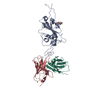 7x8yC 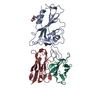 7x8zC 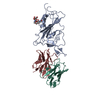 7x91C 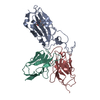 7x92C M: このデータのモデリングに利用したマップデータ C: 同じ文献を引用 ( |
|---|---|
| 類似構造データ | 類似検索 - 機能・相同性  F&H 検索 F&H 検索 |
- リンク
リンク
- 集合体
集合体
| 登録構造単位 | 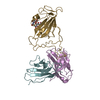
|
|---|---|
| 1 |
|
- 要素
要素
| #1: 抗体 | 分子量: 28468.092 Da / 分子数: 1 / 由来タイプ: 組換発現 / 由来: (組換発現)  Homo sapiens (ヒト) / 発現宿主: Homo sapiens (ヒト) / 発現宿主:  Homo sapiens (ヒト) Homo sapiens (ヒト) |
|---|---|
| #2: 抗体 | 分子量: 26335.391 Da / 分子数: 1 / 由来タイプ: 組換発現 / 由来: (組換発現)  Homo sapiens (ヒト) / 発現宿主: Homo sapiens (ヒト) / 発現宿主:  Homo sapiens (ヒト) Homo sapiens (ヒト) |
| #3: タンパク質 | 分子量: 141459.453 Da / 分子数: 1 / 由来タイプ: 組換発現 詳細: From aa1209, additional tags are added at the C-terminal, with Foldon sequence, TEV(tobacco etch virus) protease recognition and cleavage site, AviTag(peptide that allows for enzymatic ...詳細: From aa1209, additional tags are added at the C-terminal, with Foldon sequence, TEV(tobacco etch virus) protease recognition and cleavage site, AviTag(peptide that allows for enzymatic biotinylation),and 6xHis affinity tag. 由来: (組換発現)  遺伝子: S, 2 / 発現宿主:  Homo sapiens (ヒト) / 参照: UniProt: P0DTC2 Homo sapiens (ヒト) / 参照: UniProt: P0DTC2 |
| #4: 多糖 | 2-acetamido-2-deoxy-beta-D-glucopyranose-(1-4)-2-acetamido-2-deoxy-beta-D-glucopyranose |
| 研究の焦点であるリガンドがあるか | Y |
| Has protein modification | Y |
-実験情報
-実験
| 実験 | 手法: 電子顕微鏡法 |
|---|---|
| EM実験 | 試料の集合状態: PARTICLE / 3次元再構成法: 単粒子再構成法 |
- 試料調製
試料調製
| 構成要素 | 名称: The SARS-CoV-2 spike protein bound with the Fab fragment of a human neutralizing antibody Ab326 タイプ: COMPLEX / Entity ID: #1-#3 / 由来: RECOMBINANT | |||||||||||||||
|---|---|---|---|---|---|---|---|---|---|---|---|---|---|---|---|---|
| 分子量 | 値: 0.56 MDa / 実験値: NO | |||||||||||||||
| 由来(天然) | 生物種:  Homo sapiens (ヒト) Homo sapiens (ヒト) | |||||||||||||||
| 由来(組換発現) | 生物種:  Homo sapiens (ヒト) Homo sapiens (ヒト) | |||||||||||||||
| 緩衝液 | pH: 7.5 | |||||||||||||||
| 緩衝液成分 |
| |||||||||||||||
| 試料 | 濃度: 0.84 mg/ml / 包埋: NO / シャドウイング: NO / 染色: NO / 凍結: YES | |||||||||||||||
| 急速凍結 | 装置: FEI VITROBOT MARK IV / 凍結剤: ETHANE / 湿度: 100 % / 凍結前の試料温度: 277 K |
- 電子顕微鏡撮影
電子顕微鏡撮影
| 実験機器 |  モデル: Titan Krios / 画像提供: FEI Company |
|---|---|
| 顕微鏡 | モデル: FEI TITAN KRIOS |
| 電子銃 | 電子線源:  FIELD EMISSION GUN / 加速電圧: 300 kV / 照射モード: FLOOD BEAM FIELD EMISSION GUN / 加速電圧: 300 kV / 照射モード: FLOOD BEAM |
| 電子レンズ | モード: BRIGHT FIELD / 倍率(公称値): 105000 X / 最大 デフォーカス(公称値): 2400 nm / 最小 デフォーカス(公称値): 800 nm |
| 試料ホルダ | 凍結剤: NITROGEN 試料ホルダーモデル: FEI TITAN KRIOS AUTOGRID HOLDER 最高温度: 100 K / 最低温度: 100 K |
| 撮影 | 電子線照射量: 50 e/Å2 / 検出モード: COUNTING フィルム・検出器のモデル: GATAN K3 BIOQUANTUM (6k x 4k) |
| 画像スキャン | 動画フレーム数/画像: 40 |
- 解析
解析
| ソフトウェア |
| ||||||||||||||||||||||||||||||||||||||||
|---|---|---|---|---|---|---|---|---|---|---|---|---|---|---|---|---|---|---|---|---|---|---|---|---|---|---|---|---|---|---|---|---|---|---|---|---|---|---|---|---|---|
| EMソフトウェア |
| ||||||||||||||||||||||||||||||||||||||||
| CTF補正 | タイプ: PHASE FLIPPING AND AMPLITUDE CORRECTION | ||||||||||||||||||||||||||||||||||||||||
| 3次元再構成 | 解像度: 4.2 Å / 解像度の算出法: FSC 0.143 CUT-OFF / 粒子像の数: 42808 / 対称性のタイプ: POINT | ||||||||||||||||||||||||||||||||||||||||
| 原子モデル構築 | プロトコル: AB INITIO MODEL / 空間: REAL / Target criteria: Corelation coefficient | ||||||||||||||||||||||||||||||||||||||||
| 原子モデル構築 | PDB-ID: 5CCK Accession code: 5CCK / Source name: PDB / タイプ: experimental model | ||||||||||||||||||||||||||||||||||||||||
| 精密化 | 交差検証法: NONE 立体化学のターゲット値: GeoStd + Monomer Library + CDL v1.2 | ||||||||||||||||||||||||||||||||||||||||
| 原子変位パラメータ | Biso mean: 91.23 Å2 | ||||||||||||||||||||||||||||||||||||||||
| 拘束条件 |
|
 ムービー
ムービー コントローラー
コントローラー








 PDBj
PDBj





